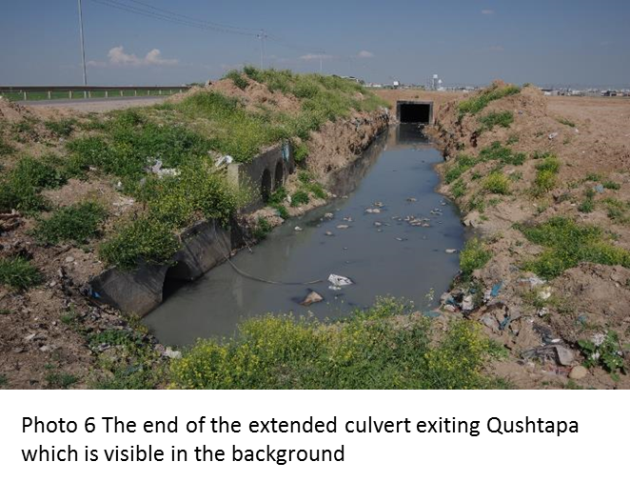
Sustainable Flood Resilience in Refugee Camps; Combining sustainable drainage (SuDS) with WASH
Posted on: November 2017Sue Charlesworth
 |
Susanne Charlesworth is a Professor in Urban Physical Geography at Coventry University in the Centre for Agroecology, Water and Resilience. She is the author of more than 50 peer reviewed journal articles on urban pollution and SUDS, many book chapters, and has co-edited books on aquatic sedimentology and water resources. She collaborates with groups internationally and has given papers at international conferences worldwide "Sustainable drainage (SUDS) seemed like the logical move from my earlier interest in urban sedimentology and geochemistry associated with rivers, streams, soil and street dusts. These materials can be highly polluted and in developed countries 85% of people live in urban areas, worldwide >50% live in cities. With climate change and the problems associated with greenhouse gases, there needs to be a means of tackling these issues with a multiple benefit, flexible approach, and SUDS can offer such a management strategy. However, its uptake in England and Wales is less than would be hoped, so through my research I would like to be able to be instrumental in providing the information necessary to encourage its uptake by practitioners and stakeholders." |
This project is sponsored by the Humanitarian Innovation Fund (HIF) and the blog below was written by the project’s Masters by Research student, Mitchell McTough and landscape architect Simon Watkins on visits to various refugee camps in the Kurdistan Region of Iraq (KRI). When camps are set up, bearing in mind these are associated with situations of crisis and offer displaced people somewhere safe, temporarily, to live, water, sanitation and hygeine are obvious priorities (WASH). However, very often greywater and surface water management are not considered until residents move in, flooding may occur, and pools of greywater appear between the dwellings. The project is to investigate using sustainable drainage techniques (mainly infiltration, bioretention and tree microcatchments) to address issues around surface water and greywater management. Simon and Mitch visited the camps to assess space considerations, access information from camp officials regarding incidences of flooding, and also to guage whether NGOs were open to the idea of considering sustainable drainage as early as possible when planning camps, and of retrofitting it instead of the ditches, concrete channels and pipes which are the current management method. Our main aim is to change policy and planning and to even suggest drainage is a human right.
Camps are largely laid out to similar spatial plans with basic drainage infrastructure including separated greywater and latrine water. However, the quality of construction both of infrastructure and buildings varies from camp to camp depending on its age, state of development, physical geography and available funding. It is therefore not possible to generalise about infrastructure or settlement pattern. The differing topography of the sites has profound and obvious consequences for surface and wastewater drainage in camps, with those constructed over undulating topography facing a different set of drainage challenges to those located on flat areas. Drainage systems for the former tend to concentrate surface and wastewaters in gullies and minor watercourses in the camps before discharging at the boundary. Conversely the challenge for drainage in flatter areas is the avoidance of stagnant pools and the management of flooding during wet periods. In both cases, however, there is often a concentration of polluted and litter-strewn channels inside the camp (Photo 1).
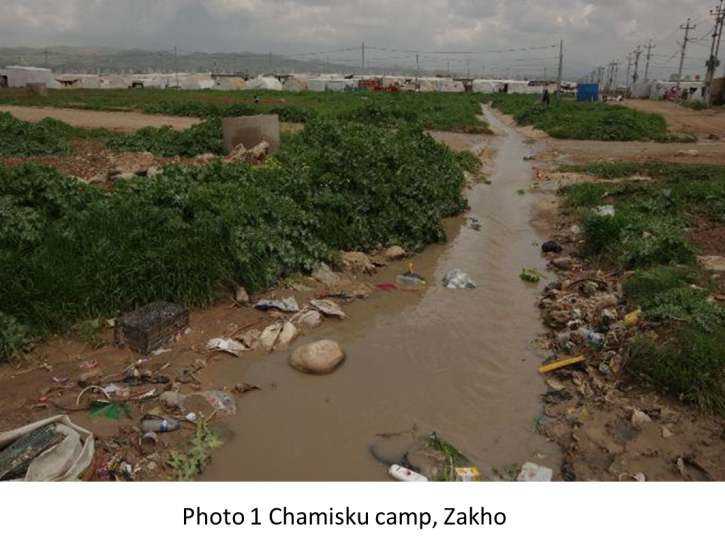
Camps are constructed by UNHCR or local government and administered by humanitarian or government agencies. The initial structure, condition and provision in camps may alter post construction according to the priorities of and resources available to these agencies. Camps tend to vary in terms of their configurations and conditions, but the poor quality of water discharged into and from drainage channels in the camps was found to be a common feature. Typically, households discharge kitchen and other washings water into open channels which are progressively combined into larger features running through the camps. The water in these channels is thickly coloured and smelling of ammonia indicating that some latrine water was also discharged into the surface water drainage system. The explanation given was that some householders attempted to connect sewerage inside their homes, bypassing the infrastructure designed to carry foul water to slurry tanks separately from surface and greywater. Further, the resulting streams were also contaminated by accumulations of litter and other debris, in places blocking outlets and causing standing pools of stagnant water both inside and immediately outside camp boundaries. In some cases, attempts had been made to clean the water using low-tech systems, or to cover the affected channels, effectively transferring the problem further downstream.
The following sections discuss conditions found in 2 camps selected for possible SuDS interventions, and a third which will be used for comparative purposes.
Darakshan Camp:
The majority of Darakshan’s road infrastructure has been upgraded to include black top with concrete surface drainage channels. Constructed on sharply undulating ground, the camp straddles the head of a small valley through which a watercourse is partly culverted, partly open, collecting washings water and surface water from either side. As with the other camps, this was heavily contaminated with suspended pollutants and litter. Waste blockages, which are commonplace, were found in the earth and retrofitted concreted drainage channels (Photo 2). Darakshan is divided into an old camp and the new. However, whilst the latter has upgraded storm water management systems installed, water is still conveyed beyond the camp boundary fence, with little thought of the effects the resulting effluent has on the surrounding landscape, or downstream communities.
A greywater treatment pilot project has been constructed in this camp, comprising a passive aggregate-based system and storage tank designed to provide irrigation water for a series of nearby polytunnels. This system works by passing controlled flows of dirty water via gravity through a series of tanks filled with progressively finer grades of aggregate. At its lowest point, the treated water is pumped to the header tank, the outflow from which is piped to the polytunnels. Crops being grown in and around the polytunnels include strawberries, runner beans, onions and young olive trees.
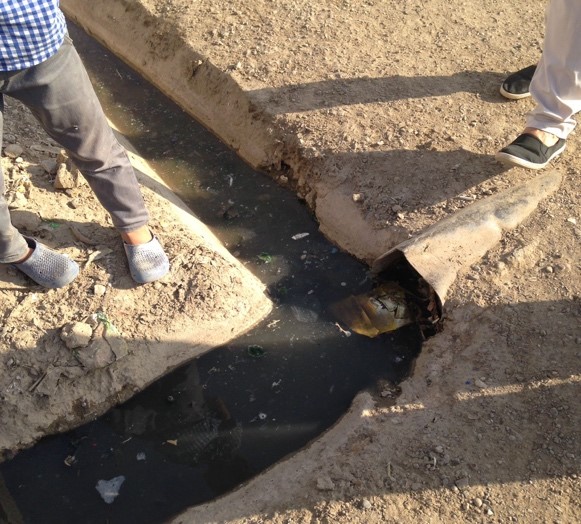
(photo 2: blocked earth and concrete drain, Darakshan)
Domiz 1 Camp:
In Domiz I, there was a combination of shallow ‘v’ channels and more substantial concrete channels covered with grates to convey surface and greywater to the camp boundary, where it was discharged to larger field drains and watercourses. One significant watercourse was culverted beneath the camp and received outflow from surface drains from the culverted section. Where the culvert exited, the stream was quite heavily contaminated with suspended pollutants, litter and other debris. This watercourse flowed into Kabarko IDP camp a few hundred metres downstream and through an area of untended damp scrubland which might provide a site to encourage further infiltration. Anecdotally, this stream was culverted due to an outbreak of cholera attributed to pathogenic pollutants in the watercourse; specifically elements of latrine water from drainage channels upstream. A site in Domiz was selected to install a swale (Photo 3). It runs along the back of some dwellings, and against the camp fence, and would be unlikely to be used to dispose of waste and become blocked. During an interview with a resident, there was interest in amenity management and maintenance by camp residents. Greywater from the drainage channels running along their property (Photo 4) was harvested for gardening purposes. Photo 5 shows a garden irrigated by greywater, the quote from the resident shows the importance of these gardens in improving quality of life and also improving the overall environment. Domiz 1 Camp: In Domiz I, there was a combination of shallow ‘v’ channels and more substantial concrete channels covered with grates to convey surface and greywater to the camp boundary, where it was discharged to larger field drains and watercourses. One significant watercourse was culverted beneath the camp and received outflow from surface drains from the culverted section. Where the culvert exited, the stream was quite heavily contaminated with suspended pollutants, litter and other debris. This watercourse flowed into Kabarko IDP camp a few hundred metres downstream and through an area of untended damp scrubland which might provide a site to encourage further infiltration. Anecdotally, this stream was culverted due to an outbreak of cholera attributed to pathogenic pollutants in the watercourse; specifically elements of latrine water from drainage channels upstream. A site in Domiz was selected to install a swale (Photo 3). It runs along the back of some dwellings, and against the camp fence, and would be unlikely to be used to dispose of waste and become blocked. During an interview with a resident, there was interest in amenity management and maintenance by camp residents. Greywater from the drainage channels running along their property (Photo 4) was harvested for gardening purposes. Photo 5 shows a garden irrigated by greywater, the quote from the resident shows the importance of these gardens in improving quality of life and also improving the overall environment.
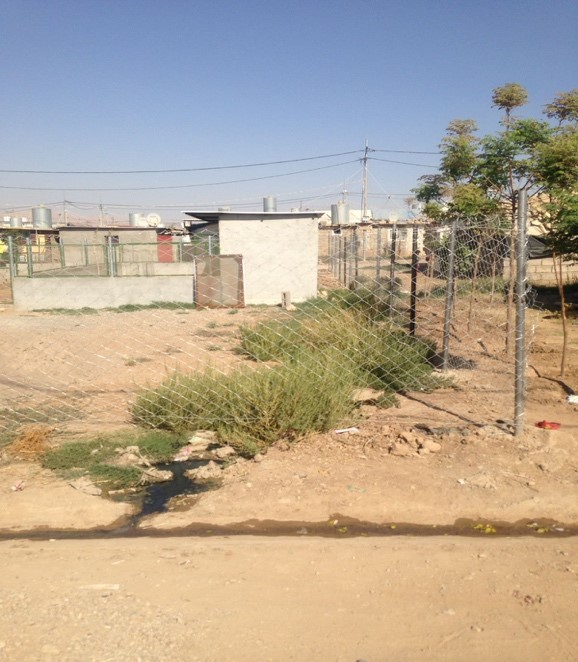
(Photo 3: proposed site for swale and aggregate footpath, Domiz 1)
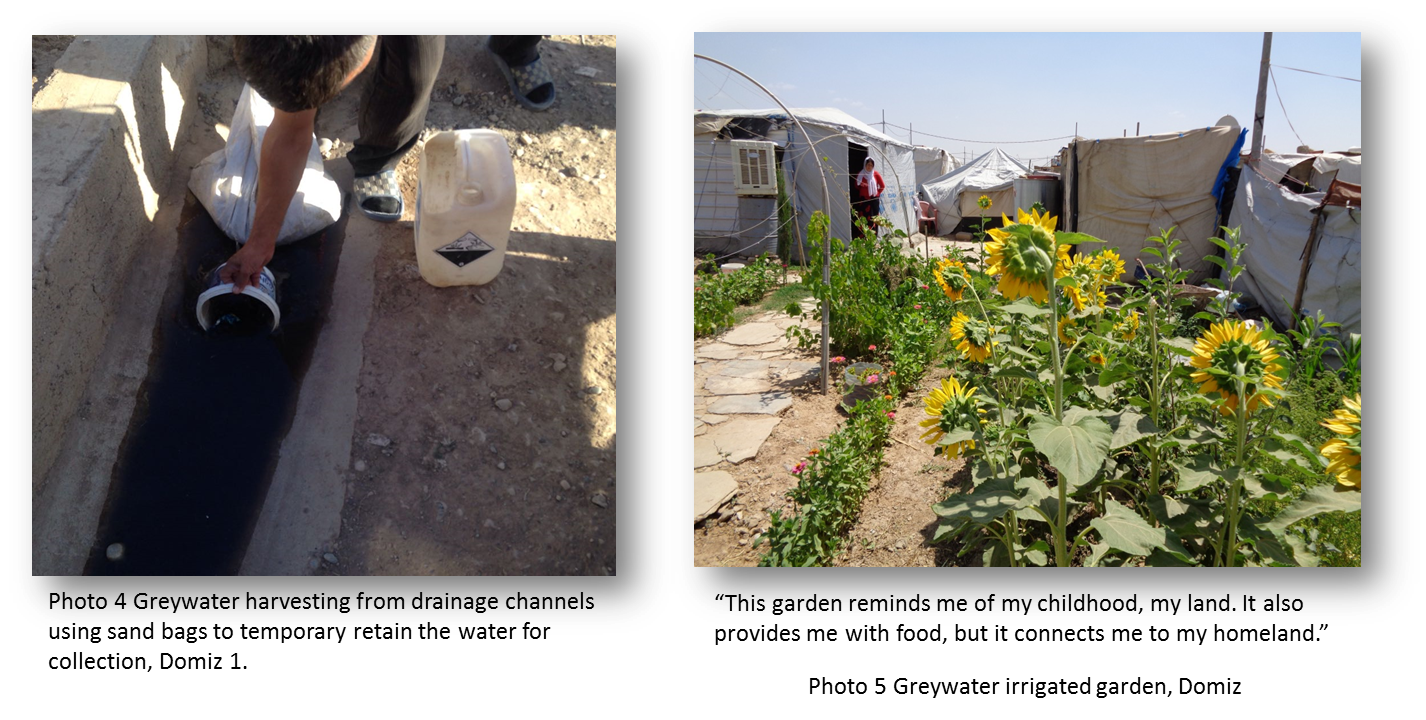
Qustapha Camp:
Qustapha camp is drained conventionally with pipes, ditches and concrete channels, these solutions in effect transferred the problem of polluted greywater to another location downstream (photo 6). It will therefore be used as a comparator of UNHCR practice with the other camps where SuDS interventions may be used.
